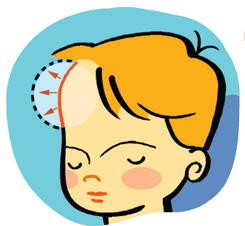 Tissue expansion is a fairly simple way for doctors to create extra skin that can be used to replace or repair skin on other parts of the body. Similar to the way a pregnant woman’s skin stretches as the baby grows inside her, tissue expansion uses a balloon called an expander to stretch the skin covering it. Over a period of several weeks, the expander is filled with liquid to gradually stretch the skin around it. When enough extra skin has been created, the tissue expansion is complete and the next step in the reconstruction can be scheduled.
Tissue expansion is a fairly simple way for doctors to create extra skin that can be used to replace or repair skin on other parts of the body. Similar to the way a pregnant woman’s skin stretches as the baby grows inside her, tissue expansion uses a balloon called an expander to stretch the skin covering it. Over a period of several weeks, the expander is filled with liquid to gradually stretch the skin around it. When enough extra skin has been created, the tissue expansion is complete and the next step in the reconstruction can be scheduled.
Expanded tissue may be used to repair skin that has been injured, burned, scarred from a previous surgery or prior to a surgery to remove large birthmarks and congenital nevi (con-GEN-it-ool NEE-vie) or hairy brown moles. It is particularly ideal for scalp repair because the stretched skin on the scalp retains normal hair growth. Most other body tissue does not grow hair to the same degree as the scalp, so tissue expansion of the scalp gives a much better appearance after the reconstruction.
Tissue expansion can be done practically anywhere on the body, and your child’s doctor will determine the best area for the expander balloon to be placed. Some common areas for tissue expansion are in the thigh, back, abdomen and scalp. Usually, the expander is placed near the site of the skin being replaced so that a flap of skin can be created. When the damaged skin is removed, the flap of extra skin is pulled into place.
Once the expander has been healed in place under your child’s skin, it will be filled with about 20 mLs (a little more than 1/2 an ounce) of sterile saline (SAY-leen) each week during the tissue expansion process. Sometimes more or less saline is used depending on the size of the expander. Saline is a liquid that is present in the body and is similar to tears, so it is completely safe to use inside the body.
Just below the surface of the skin where the expander is placed there will be a small button called a “port.” This port is connected to a tube attached to the expander and acts as a plug to keep the saline in, while allowing more saline to be added when needed. Each time your child needs to have saline added to the balloon, a special cream will be rubbed on the skin right over the port to numb it so your child will feel no pain. After about an hour, when the skin over the port is numb, a thin needle will be inserted into the center of the port to add the saline. The saline inside the balloon has some blue dye in it, so before the saline is put in, a small amount of liquid will be pulled out through the syringe (seer-RINJ) or needle to make sure the needle is in the right spot. If blue liquid is seen, the needle is in the expander and new saline will be added.
Your child may feel a bit uncomfortable just after the saline has been added to the expander, and the skin around the expander may feel taut or tight to the touch. Within a few hours, your child’s discomfort will go away, and in the days after the saline is added, the skin will stretch and feel soft again.
Expanders come in several sizes, but most expanders hold about 200 mLs of liquid, or about the same amount as in a typical juice box. If more tissue is needed, your child’s doctor may choose to use a larger tissue expander, which will create a larger bulge in the skin. Sometimes, several tissue expansions are needed to create the amount of skin needed. Your doctor will determine if a larger expander or more than one expander is needed.









 At
At  Tissue expansion is a fairly simple way for doctors to create extra skin that can be used to replace or repair skin on other parts of the body. Similar to the way a pregnant woman’s skin stretches as the baby grows inside her, tissue expansion uses a balloon called an expander to stretch the skin covering it. Over a period of several weeks, the expander is filled with liquid to gradually stretch the skin around it. When enough extra skin has been created, the tissue expansion is complete and the next step in the reconstruction can be scheduled.
Tissue expansion is a fairly simple way for doctors to create extra skin that can be used to replace or repair skin on other parts of the body. Similar to the way a pregnant woman’s skin stretches as the baby grows inside her, tissue expansion uses a balloon called an expander to stretch the skin covering it. Over a period of several weeks, the expander is filled with liquid to gradually stretch the skin around it. When enough extra skin has been created, the tissue expansion is complete and the next step in the reconstruction can be scheduled. When your child is moved to the recovery room, you will be called so that you can be there as he or she wakes up.
When your child is moved to the recovery room, you will be called so that you can be there as he or she wakes up.  If your child has any special needs or health issues you feel the doctor needs to know about, or if you have any questions, please call 412-692-8942 before the surgery and ask to speak with the nurse. It is important to notify us in advance about any special needs your child might have.
If your child has any special needs or health issues you feel the doctor needs to know about, or if you have any questions, please call 412-692-8942 before the surgery and ask to speak with the nurse. It is important to notify us in advance about any special needs your child might have.